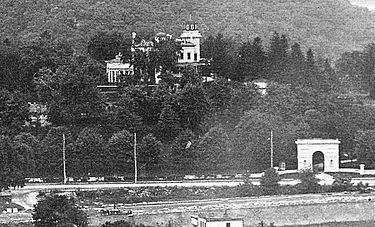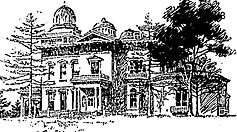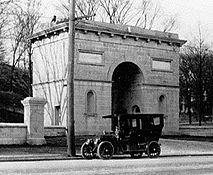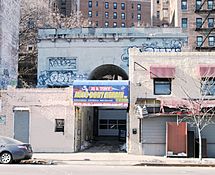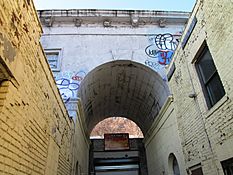Seaman-Drake Arch facts for kids
Quick facts for kids Seaman-Drake Arch |
|
|---|---|
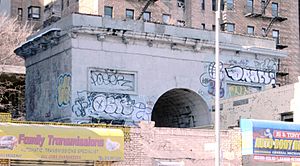
From the street. only the upper part of the arch can be seen
over the commercial buildings that obscure it from full view (2015) |
|
| General information | |
| Status | semi-abandoned, not landmarked |
| Address | 5065 Broadway at West 216th Street Inwood, Manhattan, New York City |
| Coordinates | 40°52′14″N 73°54′55″W / 40.87056°N 73.91528°W |
| Construction started | 1855 |
| Client | Seaman family |
| Height | 35 feet (10.67 m) |
| Dimensions | |
| Other dimensions | depth: 20 feet (6.10 m) width: 40 feet (12.19 m) |
| Technical details | |
| Material | Inwood marble |
The Seaman-Drake Arch, also called the Inwood Arch, is a historic stone archway. It was built in 1855 by the Seaman family in the Inwood area of Manhattan, New York City. This arch was once the grand entrance to their large hilltop estate.
You can find the arch at 5065 Broadway near West 216th Street. It was made from Inwood marble, a type of stone found nearby. The arch is about 35 feet (10.67 m) tall, 20 feet (6.10 m) deep, and 40 feet (12.19 m) wide.
Today, the arch is partly hidden by other buildings. It has also been marked with graffiti. The soft marble stone is slowly wearing away. A car repair shop uses the space behind the arch for storage. People say the arch looks like the famous Arc de Triomphe in Paris.
Contents
The Story of the Seaman-Drake Arch
Who Were the Seaman Family?
The Seaman family came from the United Kingdom. They settled in Hempstead on Long Island in the mid-1600s. Over time, they owned a very large amount of land there.
In 1851, two brothers, John Ferris Seaman and Valentine Seaman, bought a 25 acres (10.12 ha) property. This land was on a hilltop in Upper Manhattan. Their father, Dr. Valentine Seaman, was important in bringing the smallpox vaccine to the United States in the early 1800s.
The property was located near what is now Broadway. It stretched down to Spuyten Duyvil Creek. Around 1855, the Seaman brothers built a large marble house on top of the hill. They likely planned to use it as a country home. The family also had another home in lower Manhattan. The mansion first had a round dome, which was later changed to a square one.
Building the Grand Archway
The arch was built using the same marble as the mansion. It stood at the start of a road that wound up the hill to the house. The arch once had big iron gates. You can still see the places where the gates turned. It probably also had rooms inside for a gatekeeper. The arch has two empty spaces meant for statues.
John Ferris Seaman, a merchant, lived mostly in the mansion. He was married to Ann Drake. John died in 1872, and Ann died in 1878. They did not have any children. Ann Drake Seaman left the estate to her nephew, Lawrence Drake. However, 145 relatives challenged her will. The legal case was not settled until around 1893.
From Home to Clubhouse
By 1895, the mansion became the home of the Suburban Riding and Driving Club. Lawrence Drake was a member of this club. The estate already had a large marble stable. More stables and sheds were added for the club members' horses.
The inside of the mansion was changed for its new use. Bedrooms became private dining rooms. Dining halls and parlors became a café and reception area. The house's conservatory became a smoking and sun room. The club spent over $10,000 to change the house. The mansion's location was good for the club. It was near the Harlem Speedway, built in 1894-98. This speedway was only for horse-drawn carriages and horseback riders.
New Owners and Changes
In 1905, Thomas Dwyer bought the house. He lived in the mansion and used the rooms in the arch for his business. He named his business the Marble Arch Company. Dwyer was a builder. He is known for building the Soldiers' and Sailors' Monument and part of the Metropolitan Museum of Art.
Dwyer sold the Seaman-Drake estate in 1938. The land was used to build a complex of five apartment buildings. The Park Terrace Gardens, with 400 units, now stands where the mansion once was. The arch was not part of this sale.
By 1912, small brick buildings had grown up around the arch. Some of these were car dealerships that used the archway as an entrance. Since the 1960s, the arch has been part of an auto-body shop.
In 1970, a fire badly damaged the arch. It lost its roof and was open to the weather. You can see inside the arch from taller buildings nearby. Inside, the marble walls are covered with ivy. They block out most city noise, making it a quiet place.
Protecting the Seaman-Drake Arch
Efforts to Preserve the Arch
In 2003, people tried to get the arch legally protected. This is called "landmarking." New York City Councilman Robert Jackson supported this idea. However, the plan never happened.
In 2009, the property that includes the arch was listed for rent. The owner said he did not want to sell it. He inherited it from his father. His father was given the property by a man whose life he saved in World War II.
Some people were interested in renting the space. One wanted to turn the buildings into a nightclub. Others thought about a catering firm or a hair salon. By 2014, the auto body shop renting the space had moved out. The property was again listed for rent. Potential renters were interested in a bowling alley or another nightclub. The owner promised not to tear down the arch. He said, "Nobody will take the arch down ever."
As of 2015, the commercial property is still a car repair shop. The Seaman-Drake Arch has not been landmarked. It is also not listed on the National Register of Historic Places.
In 1988, Christopher Gray wrote about the arch in The New York Times:
The marble is decaying, depositing small piles of silvery grains where water drips, and the entire structure is as worn as the steps of an ancient cathedral. ... The main threat to the arch's survival seems to be New York's acidic atmosphere and rain. Until it falls or is taken down, the venerable Seaman-Drake Arch will probably continue to serve as a gateway, though of a quite different sort than that originally imagined.
Images for kids
See also
 In Spanish: Arco Seaman-Drake para niños
In Spanish: Arco Seaman-Drake para niños


